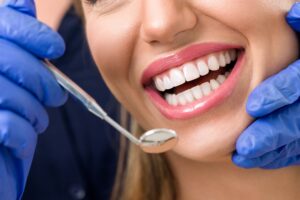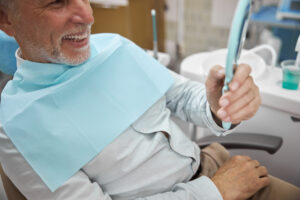Header logo
header top contact widget
Dental Technology
Contour of Gum Tissues Is Important To A Smile’s Appearance
Posted on Oct 28, 2021 by William J. Claiborne, DDS MS
When people think of their smile, they tend to think primarily of their teeth. Certainly, having white, straight teeth are a major part of a smile’s appearance. In today’s cosmetic dentistry, porcelain veneers and crowns give an exceptionally natural appearance with excellent longevity and durability. However, the gum line that borders teeth can greatly affect a smile’s appearance, perhaps more than you’ve considered.
People with unflattering smile traits tend to “hold back” when smiling. They may smile with lips only or hold a hand in front of their mouths. Some men even admit to growing a mustache that extends down over the top lip to hide the teeth visible in a smile.
In addition to placing dental implants and treating all stages of gum disease, a Periodontist specializes in the treatment of the soft tissues of the mouth. As an expert in oral tissues, my advanced training enables me to contour gum tissues to provide a natural appearance and healthy seals around the base of teeth.
For several reasons, gum tissues can pull away from the base of teeth. This can occur from gum tissues becoming drier with age or over-zealous tooth brushing. Gums can also loosen their grip around teeth when teeth tilt out of their proper positions.
When the tight seal around the base of teeth is compromised, the tooth becomes more vulnerable to oral bacteria. Darker, sensitive tooth root segments may be exposed. This not only causes sensitivity, these areas become susceptible to bacterial penetration. As an entry point for oral bacteria, the tooth roots and bones that support teeth are more vulnerable to damage as well.
In cases when a tooth breaks near the gum line, a procedure known as crown lengthening may be able to expose enough of the tooth structure so a crown can be placed. This means the natural tooth can be saved rather than require removal. Once a natural tooth is removed, it brings with it a long list of decisions and associated costs.
Although protecting and saving teeth is the priority, gum contouring procedures, such as crown lengthening are also performed to enhance the appearance of a smile. Gum re-contouring is typically referred to as a “gingivectomy”. It is performed to remove the excess gum tissue that arches over the teeth most visible in a smile.
For example, for people who have a “gummy smile,” too much gum tissue is visible above upper teeth in a full smile. A periodontist can use his or her specialized skills to reshape the tissues to provide a more balanced smile line.
In this, crowns are typically placed in addition to having the gum height adjusted. The result? A smile is greatly improved when the gum line is contoured to blend attractively with gum tissue bordering neighboring teeth.
To begin, we numb the gum tissues and carefully trim the excess. As a Periodontist, I take specific measures to ensure a natural looking arch remains over the teeth while preserving the natural points that ‘dip’ between each tooth.
A gingivectomy performed with a dental laser provides our Asheville periodontal office patients with a number of advantages: (1) enhanced comfort; (2) precision lines; (3) minimal or no bleeding; and, (4) faster healing time.
It’s normal to experience some tenderness or swelling after the procedure. However, most patients do fine by applying an ice pack off and on for the first day. In most cases, over-the-counter pain medications are sufficient, however, we make prescription strength options available to ensure comfort during the healing process. Many patients tell us they needed no medication at all.
Healing time depends on each individual and can vary from a few days to a few weeks. The dental laser we use helps to reduce the amount of time needed for healing. For patients who smoke, healing times are longer due to smoking’s drying effect on gum tissues.
Most gingivectomies are followed by porcelain veneers or crowns to give a beautiful, even smile line.
For those who have avoided gum recontouring due to dental fear, we offer several sedation options, including oral and IV sedation. Oral sedation is a pill that helps patients relax. It also has an amnesiac effect, leaving most with little or no memory of treatment afterward.
IV sedation (also known as ‘twilight sleep’) places the patient in a deeper sleep state and erases memory of the procedure. It is administered by a doctor of anesthesiology for optimal comfort and safety. In our Asheville office, anesthesia is overseen by a medical doctor (MD) who is a board certified Anesthesiologist.
With both sedation options, patients are closely monitored with advanced safety equipment throughout treatment. We help patients understand that their fears and concerns are not unusual. Our doctors and staff respect each patient and provide gentle, compassionate care – at every appointment.
Treatment fees depend on the extent of the condition and whether crowns or veneers will be applied following treatment. In either case, beautiful results can occur, helping the individual who once ‘held back’ on smiling confidently.
A healthy smile is a benefit to our overall health. An attractive, confident smile is also an asset when it comes to self-image, helping us to feel good from the inside out! Call 828-274-9440 for a consultation to discuss a gingivectomy and what may be recommended for your specific needs.
What’s Keeping You From The Dentist’s Office?
Posted on Oct 19, 2021 by William J. Claiborne, DDS MS
As an Periodontist in Asheville NC, I’ve treated many patients who, to no surprise, developed periodontal (gum) disease because of NOT going to a dentist on a regular basis.
According to the Centers for Disease Control & Prevention (CDC), nearly 65 percent of adults aged 18 and over had at least one dental visit in the past year (based on 2019).
https://www.cdc.gov/nchs/fastats/dental.htm
Unfortunately, that leaves 35 percent of adults who did not. 
The reason it is recommended to see a dentist for exams and cleanings TWICE A YEAR is because tartar, which is hardened plaque, can cause cavities and gum disease. One plaque hardens into tartar, it can no longer be brushed or flossed away. It must be removed by a dentist or hygienist using special tools.
Tartar is actually a mass of oral bacteria, which has attached itself to the base of (or in-between) teeth. Tartar (also referred to as calculus), is a colony of bacteria that thrive on oral tissues. Bacteria are living organisms and reproduce rapidly. And, the more there are, the more rapidly they amass.
So, what are the common excuses for avoiding regular dental care? See if you’ve been guilty of one or more:
COST – Some individuals feel dental cleanings and exams are expensive. Actually, there is a great deal of time and training that goes into your individualized care. In addition to the measures of sterilization and instruments, hygienists and dentists are highly-trained, educated, and must stay board certified. As for the investment, these visits are what help you avoid the need for a filling, gum disease, potential damage to teeth due to bite misalignment, and even catch oral cancer at early stages. If dental insurance is not possible, ask if payment plans are available. Many dental offices offer these, most of which are interest-free with no down payment required.
DENTAL FEAR – If fear or anxiety keeps you away from a dental chair, you are not alone. It is estimated that over 70 percent of American adults have some level of this. Sometimes the fear exists because of a traumatic experience in the past or feeling helpless in the chair. Some people react to certain smells and sounds. A few have no idea what prompted their fear, but know it is beyond their control. For these, we advise seeking dental care in a modernized office. Today’s advanced technology has greatly enhanced the level of comfort during care as well as reduced treatment time. Too, offices such as our Asheville periodontal dental office offer oral sedation as well as IV sedation (twilight sleep). These are administered by highly-skilled professionals who oversee the patient using advanced safety monitoring equipment. Ask for a consultation and tour before choosing the office that is reassuring to your unique needs.
DREAD OF BEING LECTURED – If it’s been years since you’ve seen a dentist, you may be expecting a lecture from the dentist or hygienist (or both!). My staff and I believe that is a sure way to deter someone from cultivating a positive attitude towards their dental relationship. We all want to feel respected and having a caregiver talk “down” to you is unfair, especially because no one knows the story behind your delay or avoidance. If you feel that’s going to be a problem, say so. Be upfront with “a lecture is not going to help me.” If you feel it’s a recurring problem, ask to have your records transferred to an office where you are treated more appropriately.
FEAR OF EMBARRASSMENT – Some adults feel awkward having their denture or partial removed at the dentist’s office. Some people fear they’ll gag during care, which can trigger coughing and even throwing up. Some feel their mouths are so “bombed out” that it’s embarrassing to have a dentist see how much damage has occurred. To reassure you, there is nothing we haven’t seen or experienced. Dentists have quite a lot thrown at us during dental school. As a specialist in periodontics, my additional training covered even more in-depth and complex damage or disease. DO NOT worry about your caregivers. They WANT you to rely on them to help you. Almost any dentist or specialist will tell you that our greatest joy comes from taking a patient from a “hopeless” mouth to a patient who has a healthy, confident smile!
TIME IN TREATMENT – Today’s advanced technology has greatly condensed the time needed to accurately diagnose and treatment plan almost any dental problem. Many treatments can be completed in just one or two visits. For those who have more extensive needs, dentists can sometimes combine several appointments into one long one. This is made much easier for the patient with the addition of oral sedation. Oral sedation creates a totally relaxed state so the patient can “doze” in and out of treatment. It has a quick recovery and sedated patients are carefully monitored for safety and comfort throughout treatment.
Regardless of WHY you’ve avoided the dentist, your smile is worth it! Having an appealing smile you feel joyful in sharing adds to your mood, enhances appearance and makes a positive impression to others.
If you’ve avoided dental care for years (or even decades), you may have signs or symptoms of periodontal disease. These include tender gums that may bleed when brushing, gums that recede from the base of some teeth, gums that turn red in color, and frequent bad breath. Gums are the foundation for teeth, so without healthy gums, your teeth will not be healthy, either.
Too, gum disease will only worsen without treatment. If you are a reader of my articles, you may have read the findings of research that correlates the bacteria of gum disease with serious health conditions. These include stroke, heart disease, preterm babies, some cancers, arthritis, diabetes, and erectile dysfunction.
Let us help you feel the positive aspects of achieving a healthy smile. Begin with a consultation by calling 828-274-9440.
Be “Sweet” To Your Smile By Monitoring Sugar Intake
Posted on Aug 31, 2021 by William J. Claiborne, DDS MS
If Americans truly calculated the amount of sugar they’ve consumed at the end of each day, I believe most would be shocked. Even unintentionally, sugar intake can easily reach levels that are far beyond what is assumed.
For example, in a 2015 Washington Post article, it was reported that 25 percent of catsup is sugar. Alarmingly, one tablespoon has four grams of sugar, which is more sugar than a typical chocolate chip cookie.
The World Health Organization (WHO) recommends a maximum of no more than 10 teaspoons of free sugars per day. Regardless of age, the WHO advises keeping daily sugar consumption to less than 10 percent of calories “to reduce the risk of unhealthy weight gain and dental caries.”
However, our goal in limiting sugar is often sabotaged by hidden sugars.
Sugar comes in far more forms than just the white or brown bags of granular “cane sugar” we purchase in the grocery store. If you read the list of ingredients in foods and beverages, you may be surprised at how many forms of sugar are concealed with different names. At this time, there are more than sixty.
Here’s how to catch some of them:
Added sugar may be listed as syrup (examples are corn syrup or rice syrup) or anything with an ingredient that ends in “ose” (such as fructose, sucrose, maltose, dextrose). Other examples of added sugar include fruit nectars, juice concentrates, honey, agave and molasses.
Ideally, the WHO urges an intake of no more than 6 teaspoons (or less than 5 percent) of sugars per day to “provide additional health benefits.” This is an ambitious goal for Americans who have become literally addicted to sugar.
In a study of lab rats who were provided with a diet of food and intermittent supplies of sugar water, the results showed indications of addiction and symptoms of withdrawal. https://www.sciencedirect.com/science/article/abs/pii/S0149763407000589?via%3Dihub
The study spurned on a succession of additional studies. In one, it was noted that sugar “lights up” the same area of the brain as cocaine.
https://www.businessinsider.com/sugar-has-a-similar-effect-on-the-brain-as-cocaine-2016-4
As a periodontist, I’m especially concerned about sugar intake to the detriment of oral health. Sugar lowers the natural pH levels in saliva and triggers a process that is the beginning of tooth demineralization. Demineralization describes the process where the enamel and tooth structures are dissolved.
Although sugar is not a healthy food choice for any part of the body, it is important to remember that it is the mouth that is the entry point for what we eat or drink. Thus, the destructive nature of sugar begins by causing an imbalance in the mouth through altering the healthy formulation of saliva.
For a minute, think of the foods you consumed yesterday. Coffee with sweetened creamer? Toast with jam? Sweet tea with lunch? A candy bar and cola as a mid-afternoon snack? Catsup over your fries at dinner, followed by a bowl of ice-cream?
When we are conscious of just how much sugar is being consumed over the course of a day, it becomes easier to make better choices. As we taper down little by little, it actually helps us to “wean” off the dependency of sugar so it doesn’t feel like deprivation.
As an Asheville Periodontist, I see patients every day who have periodontal disease, cavities and missing teeth that can be attributed to diet, smoking and insufficient oral hygiene. Many face involved treatment decisions that can be costly and take months to accomplish.
Although we pride ourselves on providing our patients with a comfortab
le experience backed by advanced skills and technology, so much of our treatment can be prevented with easy proactive measures. Eating a healthy diet, keeping the mouth moist, brushing and flossing, and seeing a dentist regularly are all practical ways to keep a healthy, confident smile.
Yet, “we don’t know what we don’t know.” Because our population is largely unaware of the extent of sugars in many foods and beverages, it is easy to consume far more than is realized.
 Take charge of your oral health by reading food labels, meal planning that limits sugars, and being highly committed to your oral hygiene routine at home. A few tips for a healthy mouth between dental check-ups are:
Take charge of your oral health by reading food labels, meal planning that limits sugars, and being highly committed to your oral hygiene routine at home. A few tips for a healthy mouth between dental check-ups are:
• Brush twice a day (at least) for two minutes each time. Use a fluoride toothpaste with a soft to medium bristle toothbrush.
• Floss your teeth every day before your brush to dislodge food particles caught between teeth. If flossing is difficult for you, try one of the water flossers. These are affordable and as effective as manual flossing.
• Brush your tongue after your teeth to unroot embedded bacteria, especially reaching the back area of the tongue (where most bacteria are embedded).
• Use an oral rinse that replenishes moisture twice a day (or as directed). These are available at most drug stores.
• Chew sugarless gum, preferably a brand that contains Xylitol. Xylitol looks and tastes like sugar, yet has 40 percent fewer calories.
• Drink plenty of water throughout the day. Be aware that beverages such as most coffee, tea and colas contain caffeine are drying to the mouth. Many medications also have the side effect of oral dryness – another good reason to stay hydrated.
Also, be aware of the signs and symptoms of gum disease. Sore, tender, bleeding, swollen or red gums are all warning signs. With prompt measures, we can greatly minimize treatment needs to rid your mouth of this dangerous bacteria that has been associated with a number of serious health problems (including stroke and some cancers).
If you haven’t seen your general dentist on a regular basis, call 828-274-9440. Our Asheville periodontal office can help to restore your mouth to a healthy state with the most conservative, yet effective, treatment possible.
How The Contours of Your Gums Can Enhance Smile’s Appearance
Posted on Aug 10, 2021 by William J. Claiborne, DDS MS
I remember the home of a beloved Great Aunt, whom I visited often growing up. One of the things that made her home so “homey” were the displays of bric-a-brac. As a youngster, I didn’t term her arrangements of china tea sets and Hummel figurines as bric-a-brac (they were “knick knacks,” to me). However, I found myself being drawn to her displays on shelves, in curios, and on tables moreso as I grew older.
To me, what was impressive about these groupings was how balanced they were. The china tea pots were centered, surrounded by carefully spaced cups and saucers. Hummel children were in playful arrays to appear as a happenstance assembly of friends.
As a Periodontist, I am now far more appreciative of how my Aunt kept such proper balance to these displays. Everything seemed so coordinated, harmonized.
As a specialist in the treatment of all stages of periodontal (gum) disease and the placement of dental implants, I am also the expert when it comes to the contours of gum tissues surrounding teeth. The gums are important to the health of your teeth as well as the appearance of a smile.
When it comes to protecting teeth, think of the gum tissues as a protective blanket. The gums cover over the under-structures of the mouth’s interior (oral cavity). If you’ll look at the base of each tooth, you’ll see that the gum tissues snugly wrap the base of each tooth. This protective seal is what prevents bacterial penetration below the gum line.
When gum tissues loosen their grip around teeth, the leading cause is gum disease. Gum disease weakens oral tissues and causes them to become inflamed. As the gums loosen, bacteria is able to work their way into the structures that support natural teeth (including bone).
When bacteria reach this level of oral structures, ridding it involves a more involved procedure than what a mere dental cleaning can combat. As it progresses, the gums become spongy and pus pockets form. Teeth loosen and may need removal. Gum disease is the leading cause of adult tooth loss.
Yet, gum tissues not only serve as a protective element of your mouth. The appearance of a smile can be greatly affected by the shape and amount of gum tissues exposed when smiling.
Balance is an element of beauty, according to studies. We are drawn to it. According to Penn State’s “Science in Our World: Certainty and Controversy”,
“Studies show that symmetrical faces are preferred and more attractive to others than people who have asymmetrical faces. Similarly shaped eyes and eyebrows, sides of the nose mouth can all fall into the symmetrical category.”
They shared findings of one study, performed over the course of two decades, that had men and women rank the attractiveness of people in photos. The study revealed:
“Men and women both overwhelmingly chose the most symmetric face. This test was an observational study, so it was only as clear and truthful as the participants of the study were. There wouldn’t really be a way to make this sort of study an experimental test, so as far as attraction goes, studies must rely on the opinions of the participants. However, the majority of the participants chose the most symmetrical faces as the most attractive ones, so it is easily said that it is true, symmetry equals attractiveness.”
http://www.livescience.com/7023-rules-attraction-game-love.html
Although “beauty is in the eye of the beholder,” symmetry seems to be a component of what humans define as beautiful and what we’re drawn to (although inner beauty is an important factor in what keeps us connected to an individual).
When a smile shows too much or too little gum tissue bordering the tops of teeth, it moves the smile line out of balance. For example, in a “beautiful” smile, the arches of gum tissues visible in a full smile are at a similar level. The amount of gum arches are in a complimentary line to teeth, rather than an amount that draws the eye. Too much gum tissue showing is referred to as a “gummy smile.”
A gummy smile is not an unattractive feature. Having one does, however, alter the appearance of a smile based on balance. For example, a diastema is a wide space between the two front teeth. It is often a hereditary trait. Although it is not unattractive feature, the eye seems drawn to that one spot rather than seeing the smile, as a whole, as a complement to other facial features. The individual may have beautiful lips or eyes, but the gap between the teeth is what is noticed as being “off.”
Quite frankly, some people are perfectly comfortable with having a gummy smile or a diastema. For them, it’s part of their personality or signature look. After all, what would Lauren Hutton, the famous model of the 70’s, have been without her diastema?
For other people, these features cause shyness, insecurity or a feeling of awkwardness. Some people try to smile with lips only. Others try to conceal a full smile with a hand. “Holding back” on a smile is a shame, especially since smiling is a proven asset to our frame of mind.
The act of smiling causes the brain to release chemicals known as endorphins. These trigger somewhat of a natural high, creating a happier mood. This has been shown to be true even when faking a smile.
Additionally, people who smile often are deemed happier, more confident and even younger. In smiling, the facial muscles pull upward and smooth out the skin to give the face a bit of a lift. Free of charge!
Another distortion in a balanced smile can be an uneven line of gum tissues, where there is more gum showing on some teeth than others. This up-and-down line of gum tissues creates a jumbled look. Again, the appeal of balance is disrupted.
In these cases, a “crown lengthening“ procedure is often advised. This is a simple procedure that alters the height of the gum tissues prior to placement of a crown (‘cap’). Not only does this provide a more flattering smile line, it protects the teeth involved while enhancing the tooth’s shape.
Another issue that impacts both appearance and the health of a tooth is gum recession. When the gums recede from the base of teeth, more sensitive and vulnerable areas of the tooth’s root are exposed. Exposure can lead to sensitivity and higher risk for bacterial penetration.
The procedure for most gum recontouring is known as a Gingivectomy. In this, our Asheville Periodontal dental office uses a dental laser. Gingivectomy is the most common procedure performed with a laser, which is used to precisely contour gingiva (gum tissue) for restorative, cosmetic, and periodontal needs.
The laser promotes rapid healing and reduces discomfort post-operatively with periodontal packing or sutures rarely needed. In the hands of a skilled periodontal specialist, laser technology also minimizes penetration depths. For minor procedures, lasers can sometimes require little or no anesthetic.
For more involved gum contouring, our Asheville periodontal office offers both oral and I.V. sedation. Oral sedation is a pill that helps patients relax. It also has an amnesiac effect, leaving most with little or no memory of treatment afterward.
I.V. sedation places the patient in a deeper sleep state, also erasing memory of the procedure. It is administered by a doctor of anesthesiology for optimal comfort and safety. In our office, this is overseen by Dr. Brad Stone, a Medical Doctor (MD) who is a board certified Anesthesiologist & Pediatric Anesthesiologist.
With both sedation options, patients are closely monitored with advanced safety equipment throughout treatment.
The health and appearance of your smile are important. It is proven that good oral health is a supportive component to your overall health. It is also shown that the appearance of a smile can add positively to an individual’s perception of “self”.
If you’re interested in improvements in the health and appearance of your smile, let’s discuss the possibilities during a consultation appointment. Call 828-274-9440. A referral is not always needed.
Recent Posts
Categories
Archives
- September 2024
- August 2024
- July 2024
- June 2024
- May 2024
- April 2024
- March 2024
- February 2024
- January 2024
- December 2023
- November 2023
- October 2023
- September 2023
- August 2023
- July 2023
- June 2023
- May 2023
- April 2023
- March 2023
- February 2023
- January 2023
- December 2022
- November 2022
- October 2022
- September 2022
- August 2022
- July 2022
- June 2022
- May 2022
- April 2022
- March 2022
- February 2022
- January 2022
- December 2021
- November 2021
- October 2021
- September 2021
- August 2021
- July 2021
- June 2021
- May 2021
- April 2021
- March 2021
- February 2021
- January 2021
- December 2020
- November 2020
- October 2020
- September 2020
- August 2020
- July 2020
- June 2020
- May 2020
- April 2020
- March 2020
- February 2020
- January 2020
- December 2019
- November 2019
- October 2019
- September 2019
- August 2019
- July 2019
- June 2019
- May 2019
- April 2019
- March 2019
- February 2019
- January 2019
- December 2018
- November 2018
- October 2018
- September 2018
- August 2018
- July 2018
- June 2018
- May 2018
- April 2018
- March 2018
- February 2018
- January 2018
- December 2017
- November 2017
- October 2017
- September 2017
- August 2017
- July 2017
- June 2017
- May 2017
- April 2017
- March 2017
- February 2017
- January 2017
- December 2016
- November 2016
- October 2016
- September 2016
- August 2016
- July 2016
- June 2016
- May 2016
- April 2016
- March 2016
- February 2016
- January 2016
- December 2015
- November 2015
- October 2015
- September 2015
- August 2015
- July 2015
- June 2015
- May 2015
- April 2015
- March 2015
- February 2015
- January 2015
- December 2014
- November 2014
- October 2014
- September 2014
- August 2014
- July 2014
- June 2014
- May 2014
- April 2014
- March 2014
- February 2014
- January 2014
- December 2013
- November 2013
- October 2013
- September 2013
- August 2013
- July 2013
- June 2013
- May 2013
- April 2013
- March 2013
- February 2013
- January 2013
- December 2012
- November 2012
- October 2012
- September 2012
- August 2012
- July 2012
- June 2012


